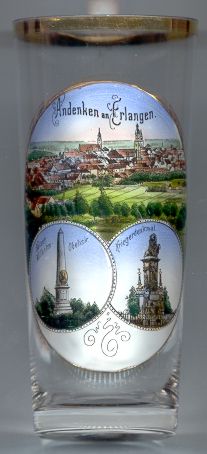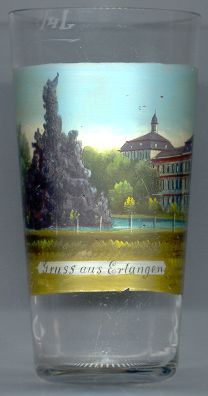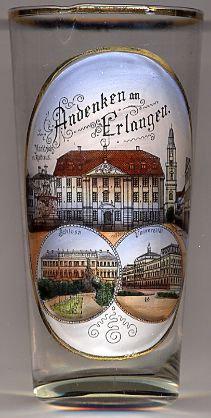

|
| DEUTSCHLAND | GERMANY |
| Bundesland: Freistaat Bayern | Bavaria |
| Regierungsbezirk: Mittelfranken | |
| Stadt: Erlangen |
Erlangen is situated at an elevation of 281 m on the river Regnitz and the stream Schawbach.
The village Erlang, which was mentioned in a document of 1002, was located on the left bank of the Regnitz and later became known as
Weningenerlang or Kleinerlang (today it is called Alterlangen and is part of the city of Erlangen). The village Großenerlang
on the right bank of the river was purchased by Emperor Karl IV in 1361. It received the status of a market town in 1374 and was chartered
as a city in 1398. This town later became known as the Altstadt (old town) of Erlangen. After 1400 this town came in possession of the
 burgraves of Nuremberg, who later obtained the title of margraves of Brandenburg.
During the two Margraves' Wars of 1449–1451 and 1552–1554 the Margraves Albrecht Achilles of Brandenburg-Ansbach and
Albrecht Alcibiades of Brandenburg-Kulmbach in vain tried to form a Frankish dukedom which should have included the
possessions of the bishopric of Bamberg and the free Imperial city of Nuremberg.
In 1528 the Reformation was introduced in Erlangen. When Louis XIV of France revoked the Edict of Nantes in 1685, Margrave Christian Ernst
of Brandenburg-Bayreuth admitted the Huguenots into his country and founded the Neustadt (new town) of Erlangen in 1686.
This town, which received the name Christian-Erlang, was laid out in Baroque style according to a regular ground plan.
The Altstadt was destroyed by a large fire in 1706 and was rebuilt, also in Baroque style, in parallel to the construction of the Neustadt.
In 1708, Christian-Erlang was chartered and became one of the residence towns of the margraviate. In 1743 Margrave Friedrich relocated the
university, which he had founded in Bayreuth only one year earlier, to Erlangen. The house of Brandenburg-Ansbach
succeeded the line of Brandenburg-Bayreuth in 1769. In 1792 the Brandenburg-Ansbach lands became part of Prussia. In 1807, Erlangen was occupied by French troops and finally became part of the Kingdom of Bavaria
in 1810. Altstadt Erlang and Neustadt Christian-Erlang were united to the city of Erlangen in 1812.
burgraves of Nuremberg, who later obtained the title of margraves of Brandenburg.
During the two Margraves' Wars of 1449–1451 and 1552–1554 the Margraves Albrecht Achilles of Brandenburg-Ansbach and
Albrecht Alcibiades of Brandenburg-Kulmbach in vain tried to form a Frankish dukedom which should have included the
possessions of the bishopric of Bamberg and the free Imperial city of Nuremberg.
In 1528 the Reformation was introduced in Erlangen. When Louis XIV of France revoked the Edict of Nantes in 1685, Margrave Christian Ernst
of Brandenburg-Bayreuth admitted the Huguenots into his country and founded the Neustadt (new town) of Erlangen in 1686.
This town, which received the name Christian-Erlang, was laid out in Baroque style according to a regular ground plan.
The Altstadt was destroyed by a large fire in 1706 and was rebuilt, also in Baroque style, in parallel to the construction of the Neustadt.
In 1708, Christian-Erlang was chartered and became one of the residence towns of the margraviate. In 1743 Margrave Friedrich relocated the
university, which he had founded in Bayreuth only one year earlier, to Erlangen. The house of Brandenburg-Ansbach
succeeded the line of Brandenburg-Bayreuth in 1769. In 1792 the Brandenburg-Ansbach lands became part of Prussia. In 1807, Erlangen was occupied by French troops and finally became part of the Kingdom of Bavaria
in 1810. Altstadt Erlang and Neustadt Christian-Erlang were united to the city of Erlangen in 1812.
The  Kaiser-Wilhelm-Obelisk [bottom left picture] was erected in 1897 on the occasion of the
100th anniversary of the birth of the first German Emperor, Wilhelm I. It was the first monument for Wilhelm I in southern Germany.
The circle around the marble obelisk soon after was named Kaiser-Wilhelm-Platz. In 1942 the metal parts of the monument including 4 bronze
reliefs were removed and melted down. The monument was removed in 1946 and the square was renamed Lorlebergplatz in honour of
colonel Werner Lorleberg who had delivered the city to the US Army without struggle in 1945 and thus prevented the destruction of the town.
Kaiser-Wilhelm-Obelisk [bottom left picture] was erected in 1897 on the occasion of the
100th anniversary of the birth of the first German Emperor, Wilhelm I. It was the first monument for Wilhelm I in southern Germany.
The circle around the marble obelisk soon after was named Kaiser-Wilhelm-Platz. In 1942 the metal parts of the monument including 4 bronze
reliefs were removed and melted down. The monument was removed in 1946 and the square was renamed Lorlebergplatz in honour of
colonel Werner Lorleberg who had delivered the city to the US Army without struggle in 1945 and thus prevented the destruction of the town.
Several glasses of this collection show other monuments for Wilhelm I.
The  Kriegerdenkmal (soldiers' monument) [bottom right picture] on the Martin-Luther-Platz
was erected in 1890 to commemorate the French-German war of 1870/1871 that had led to the foundation of the German Empire in 1871.
The sandstone monument, which shows the Bavarian lion holding the city arms of Erlangen, was removed in 1952 to make way for the increasing traffic.
The sculpture of the lion was relocated to the Altstadtmarkt.
Kriegerdenkmal (soldiers' monument) [bottom right picture] on the Martin-Luther-Platz
was erected in 1890 to commemorate the French-German war of 1870/1871 that had led to the foundation of the German Empire in 1871.
The sandstone monument, which shows the Bavarian lion holding the city arms of Erlangen, was removed in 1952 to make way for the increasing traffic.
The sculpture of the lion was relocated to the Altstadtmarkt.

The  Hugenottenbrunnen (Huguenots' fountain) [right, no. 1788]
in the park of the margraves' palace was created in 1706 by Elias Räntz, sculptor to the court at Bayreuth.
The lower parts of the fountain refer to the Huguenots who were admitted to this country by Margrave Christian Ernst after 1685.
The top part shows a statue of Christian Ernst, surmounted by the figure of Fama, the persionification of glory.
The total height of the sandstone construction is 12 metres. Originally, 9 fountains gushed water over the construction.
Today, there are only 2 simple fountains in the water basin. The park is open to the public since 1849.
Hugenottenbrunnen (Huguenots' fountain) [right, no. 1788]
in the park of the margraves' palace was created in 1706 by Elias Räntz, sculptor to the court at Bayreuth.
The lower parts of the fountain refer to the Huguenots who were admitted to this country by Margrave Christian Ernst after 1685.
The top part shows a statue of Christian Ernst, surmounted by the figure of Fama, the persionification of glory.
The total height of the sandstone construction is 12 metres. Originally, 9 fountains gushed water over the construction.
Today, there are only 2 simple fountains in the water basin. The park is open to the public since 1849.

The  Palais Stutterheim on Market Square [left, no. 2511: top picture]
was built in 1728–1730 for Christian Hieronymus von Stutterheim using a design by Wenzel Perner.
When the margraves' palace was destroyed by the large fire of 1814 it served for three years as home of Sophie Caroline Marie,
widow of Margrave Friedrich III of Brandenburg-Bayreuth.
From 1836 until 1971 it was used as the town hall of Erlangen (hence the labeling 'Rathaus' on the glass).
Today it is the home of Erlangen's municipal library, the municipal art gallery and Erlangen's historical society.
Palais Stutterheim on Market Square [left, no. 2511: top picture]
was built in 1728–1730 for Christian Hieronymus von Stutterheim using a design by Wenzel Perner.
When the margraves' palace was destroyed by the large fire of 1814 it served for three years as home of Sophie Caroline Marie,
widow of Margrave Friedrich III of Brandenburg-Bayreuth.
From 1836 until 1971 it was used as the town hall of Erlangen (hence the labeling 'Rathaus' on the glass).
Today it is the home of Erlangen's municipal library, the municipal art gallery and Erlangen's historical society.
The  Margraves' Palace [left, no. 2511: bottom left picture]
was created in 1700. Together with the palace gardens, the orangery and the Concordia Church it is the earliest Baroque ensemble in Franconia.
Antonio della Porta began the construction in 1700 by order of Heir Apparent Prince Georg Wilhelm. After the death of the architect the works
were continued by Gustav von Gedeler who completed the construction in 1704. Already in 1703 Margrave Christian Ernst gave the, still uncompleted, palace
as a gift to his third wife, Elisabeth Sophie. The palace gardens behind the palace were laid out in the following years.
In January 1814 the palace caught fire. The structure was completely destroyed, only the furniture could be saved.
It took until 1821 that the construction of a new palace, built to plans of Friedrich Wilhelm örtel, could be commenced.
The new structure was completed in 1825. Since then, the building is used by the University of Erlangen.
During the two World Wars the building served as a military hospital. Since 1945 it is used exclusively by the administration of the university.
Margraves' Palace [left, no. 2511: bottom left picture]
was created in 1700. Together with the palace gardens, the orangery and the Concordia Church it is the earliest Baroque ensemble in Franconia.
Antonio della Porta began the construction in 1700 by order of Heir Apparent Prince Georg Wilhelm. After the death of the architect the works
were continued by Gustav von Gedeler who completed the construction in 1704. Already in 1703 Margrave Christian Ernst gave the, still uncompleted, palace
as a gift to his third wife, Elisabeth Sophie. The palace gardens behind the palace were laid out in the following years.
In January 1814 the palace caught fire. The structure was completely destroyed, only the furniture could be saved.
It took until 1821 that the construction of a new palace, built to plans of Friedrich Wilhelm örtel, could be commenced.
The new structure was completed in 1825. Since then, the building is used by the University of Erlangen.
During the two World Wars the building served as a military hospital. Since 1945 it is used exclusively by the administration of the university.
The  Kollegienhaus [left, no. 2511: bottom right picture; and above right, no. 1788]
was built in 1889 as an extension of the university and served as central lecture hall and representative building of the university.
Kollegienhaus [left, no. 2511: bottom right picture; and above right, no. 1788]
was built in 1889 as an extension of the university and served as central lecture hall and representative building of the university.
The university was founded in 1742 in Bayreuth by Friedrich III, Margrave of Brandenburg-Bayreuth, and moved to Erlangen in 1743. From the beginning,
the university was a Protestant institution, but it slowly secularized. During the Nazi era, the university was one of the first that had a majority of
Nazi supporters in the student council. In 1961 the business college in Nuremberg was merged with the university in Erlangen, which led to the present
state of a university divided between two towns. A technical faculty was inaugurated in 1966 and the pedagogical college in Nuremberg became part of the
university in 1972. Today the university is named Friedrich-Alexander University after its founder Margrave Friedrich III of Brandenburg-Bayreuth (r.1735–1763)
and Margrave (Christian Friedrich) Karl Alexander of Brandenburg-Ansbach (r.Ansbach since 1757, r.Bayreuth since 1769, abd.1791, d.1806), important patron of the university and last
margrave of Brandenburg-Anbach and Bayreuth.
![[scale]](lineal.jpg)